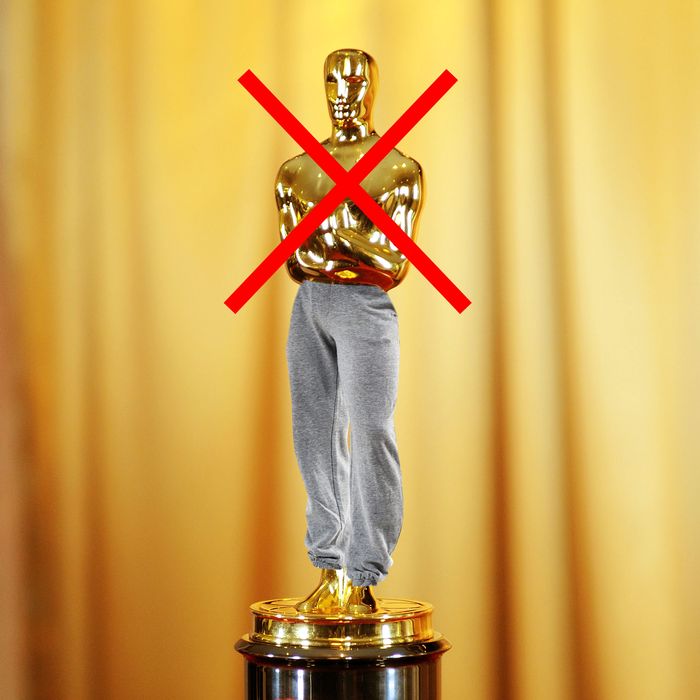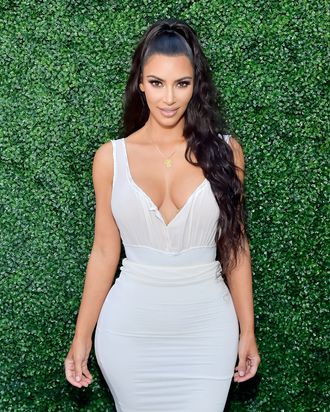
Before the Oscars this Sunday, the show’s producers — Steven Soderbergh, Stacey Sher, and Jesse Collins — sent out an email to nominees that basically said, “Here’s how this is going to go.” It detailed safety precautions (guests can go maskless, but will be tested), attendance protocols (Zooming in “will not be an option”), and helpful speech-giving tips (“READ THE ROOM”). It also included some strongly worded suggestions on dress code.
“We’re aiming for a fusion of Inspirational and Aspirational,” the letter reads, capitalizing Inspirational and Aspirational for inspirational and aspirational emphasis. “In actual words,” it continues, “Formal is totally cool if you want to go there, but casual is really not.”
There are a lot of things about this sentence that rub me the wrong way, but ironically, the most striking thing about it is how casual it sounds. The tone is so flip — so Mean Girls passive aggressive — that I have to laugh, if only out of reflexive nervousness that I will be somehow punished if I don’t. Even if the producers had said “casual isn’t cool, guys” in the nicest way possible, though, I still think that I’d have to politically disagree.
Of course, half of the fun of the Oscars is seeing celebrities all dressed up on the red carpet. Like the event’s producers, I agree: Formal is great. I’m certainly not pining after seeing David Fincher in sweatpants. I’ve enjoyed watching political figures and celebrities go above and beyond, fashion-wise, for various ceremonies this year. Dressing up has always been an integral part of how we celebrate and mourn, and I would never imply that we should do away with that ritual. But what I’m getting from this Oscars dress code this year is that “casual” attire, whatever that means, isn’t capable of being both Inspirational and Aspirational — an idea that, as this year has proven, is simply not true. Even Vogue agrees! Casual can be tailored and glamorous and dignified. Really, it can be whatever you want.
In a moment when the Oscars are doing away with convention in so many ways, asking for traditionally formal dress seems, to me, like a missed opportunity to allow attendees to express themselves fully and in a way that feels truly modern and reflective of where fashion is currently headed.
The Oscars have always had a dress code. In 1968, on the 40th anniversary of the ceremony, costume designer Edith Head sent out a similar (though more dignified) memo to Academy Awards attendees. At this point, Head had been nominated 35 times for her work shaping Hollywood glamour as we know it and had served as a fashion consultant for the Academy for almost two decades. This was before brands like Armani began dressing stars, before stylists got involved, before “best” and “worst” dressed lists. Studios, and costume designers like Head, were the ones pulling the strings.
“Actresses are requested to wear formal evening gowns either maxi or floor length, preferably pastel shades since the setting is very formal and done entirely in white and gold,” Head’s letter reads. “As you know, long dresses (no mini or day length) are more graceful on stage and on camera in this type of background.”
Clearly, Head believed in formality. “The Academy feels that the dignity of traditional affair on our 40th Anniversary deserves formal dress,” she concludes. (She then offers her home phone number, in case she can be of any more assistance.) But what this memo reveals is that in addition to making sure the show looked stylish and put together, her role was to coach stars on how to look good specifically through a screen — something we’re all perhaps too good at today.
Because of the pandemic, celebrities (and their stylists) had to get creative when it came to making onscreen fashion statements, from graphic T-shirts and hoodies worn on the couch to ball gowns worn while submerged in a backyard swimming pool. To me, the range of virtual-friendly styles on display this year provided a much-needed injection of personal expression into what had otherwise become a stale ritual. Red-carpet fashion has increasingly become an ad for brands and their celebrity ambassadors, divorced from reality in a way that feels hollow rather than fantastical. All the pandemic-inspired experimentation brought it back to life.
It was inevitable that awards shows would eventually return to normal, but I guess I naïvely hoped that the red carpet and its rules would be forever changed by our year of virtual dress-up. You’re telling me there’s a more fun, more surprising option out there, and we’re choosing to go back to the same old boring commercial Barbie-doll thing that we’ve been doing for 93 years??
Of course, the show must go on. “We are going to great lengths to provide a safe and ENJOYABLE evening for all of you in person, as well as for all the millions of film fans around the world,” the producers’ memo explains, “and we feel the virtual thing will diminish those efforts.”
Instead of a “virtual thing,” the Oscars are poised to be more like a narrative film this year. There is no host; presenters serve as part of a “cast,” as director Glenn Weiss told Vulture, helping move the plot along throughout the night. In this way, it makes sense that they’d ask everyone to dress the part and stick to the script. “If you’re thanking someone, say their name, not their title,” reads the producers’ memo. “Don’t say MY MANAGER, PEGGY just say PEGGY. Make it PERSONAL.”
But if they want it to really be PERSONAL, shouldn’t they give people the room to experiment with style? As we’ve seen in the past, some of the most memorable Oscars outfits have been the ones that play with boundaries. Think Sharon Stone wearing a Vera Wang skirt with a Gap button-down; Demi Moore wearing bike shorts; Frances McDormand in Valentino Birkenstocks. I’ve even warmed up to the idea that Timothée Chalamet’s casual Prada suit from last year was actually ahead of its time. To assume that audiences only want to see formal attire feels very early-pandemic “Imagine” video to me, in the sense that Hollywood has a tendency to misjudge how seriously it should take itself.
Understandably, some people see it as disrespectful to dress casually for an important occasion. But the Oscars are not sacred. They are, like runway shows, meant to be a reflection of culture, whatever that looks like in any given year. And over the last 12 months, designers have demonstrated that there are ways to do casual that are actually quite formal, and vice versa. The Oscars are also meant to attract an audience and keep them hooked for, like, 100 hours. This year, I don’t want to see the same old, same old. I want to see an explosion of personal style that plays with the boundaries of clothing in ways that make me want to dive into my screen and steal it for myself.
Back in the 1970s, Edith Head said that, given the dignified role that the Academy Awards play in culture, she didn’t expect stars to show up in “freaky, far out, unusual fashions.” But 50-something years later, in the year 2021, doesn’t that sound great?
The Link LonkApril 24, 2021 at 07:00PM
https://ift.tt/2Qk6C0x
The Oscars Dress Code Is Kind of a Bummer - The Cut
https://ift.tt/2KksXom
Dress

No comments:
Post a Comment